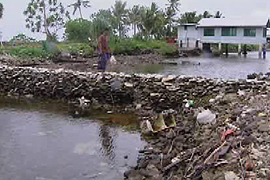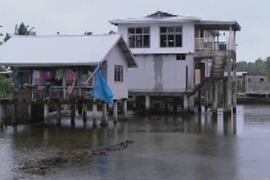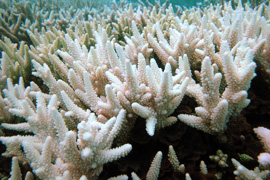The Pacific’s climate refugees
Al Jazeera meets residents of Tuvalu who may leave their homes to avoid rising seas.

 |
| Rick says islanders are being “kicked out of their homes” |
The Intergovernmental Panel on Climate Change (IPCC) report released on Friday may be full of dire predictions, but in the tiny Pacific nation of Tuvalu the situation is already grim.
Keep reading
list of 4 itemsAfter the Hurricane
World’s coral reefs face global bleaching crisis
Why is Germany maintaining economic ties with China?
Sea levels there have already risen by 10-25 cm in the past 100 years and global warming threatens to raise the oceans higher still.
Scientists say that higher sea levels could destroy corals and swamp Tuvalu and other low-lying nations in the Pacific, rendering them entirely uninhabitable.
Some predict a rise of just 40cm in sea levels would be enough to kill off vegetation on the island.
The new IPCC report lays the blame for climate change squarely on human activity but many of Tuvalu’s 10,000 citizens feel they bear little responsibility for the problem.
Nontheless, they fear they will soon be among the world’s first “climate refugees”.
Borrowed time
The rising sea already threatens Tuvalu from all sides, with the Pacific Ocean biting chunks from one coastline and a large lagoon advancing on the other.
| Your Views |
But perhaps an even more serious problem for the island is the infiltration from underneath its surface, which results in so-called “borrow pits”.
Tuvalu’s porous foundations are no match for the ocean’s power as it percolates to the surface.
Borrow pits are so named because the coral that was dug up, or temporarily “borrowed” to build a runway during World War 2, was supposed to be returned but never has been.
Paani Laupepa, the country’s secretary for foreign affairs, says that because Tuvalu is only 26 square km in area there is simply nowhere for people to escape the problems.
 |
| “Borrow pits” threaten the foundations of many homes |
“There’s no mountains to climb to,” he says.
“The best you can do is strap yourself onto a coconut tree and hope for the best, because that’s the highest point on this land.”
Those that can afford to do so build houses on stilts, but many islanders just deal with the problems one day at a time.
Iefata Paeniu’s house occupies one of the most vulnerable positions inside the borrow pits.
The last king tide soaked his floor but he is not planning to move.
“I’ve always thought that this is where I belong. I’ll see how I cope with it, it’s quite difficult but something that I think I will live with,” he says, managing to laugh.
But among the younger generation there are plenty who want to leave.
Destination unknown
Rick Taupo is one islander who made up his mind when the last big storm sent waves crashing into his parents’ front garden.
“I truly want to be overseas so that my kids will be safe, my grandkids will be safe, and we won’t face any danger like this,” he says.
Many islanders, keen to escape to higher ground, believe – along with many environmentalists -they should be accorded refugee status and all the immigration benefits included therein.
But there remains the issue of who would take in any future climate refugees.
New Zealand currently accepts 75 Tuvaluans each year as part of a Pacific Access Category agreement reached in 2001.
 |
| Not all Tuvaluans can afford homes on stilts |
Australia, however, accepts no Tuvaluans – despite statistics showing it has, per capita, the highest greenhouse gas emissions in the world.
“We’re basically being kicked out of our homes and its really sad that we can’t stay here. This is our land, our culture, our way of life,” Rick says.
Scientific opinion varies on how long Tuvalu has left, given the current rises in sea levels, but some say another 40 cm will be enough to kill off the island’s vegetation.
Laupepa says the climate problems are having an effect on people.
“We have the least to do with these problems and yet we are being forced to think about [having to] move,” he says. “That’s very upsetting – it makes people angry, you know.”
But if Tuvalu goes underwater, the ocean itself will also pay a heavy price. Decades worth of rubbish stored on the island will wash away into the pristine waters of the Pacific.
Most islanders are afraid the IPCC report will be too little too late, but they still hope the biggest polluters will have a change of heart.
As Laupepa says: “We are all on the same boat. This planet belongs to everyone on this earth and we have to play our role in keeping this ship afloat.”
| Troubled waters | ||
|
Following the IPCC report on climate change, here are some facts about the world’s seas.
1. Oceans cover 70 per cent of the world’s surface and more than 90 per cent of the world’s living biomass is found in the oceans. 2. More than 3.5 billion people depend on the seas for their primary source of food. The numbers could double to 7.0 billion in 20 years. 3. Over 70 per cent of the world’s marine fisheries are fished up to or beyond their sustainable limit. Stocks of fish such as tuna, cod, swordfish and marlin have declined by up to 90 per cent in the past century. 4. 80 percent of all pollution in the seas comes from land-based activities. By 2010, 80 per cent of the world’s population will live within 100 km of coastlines. 5. An estimated 21 million barrels of oil run into the oceans every year from sources ranging from run-off from streets to ships flushing their tanks. 6. Deaths and diseases caused by polluted coastal waters cost the global economy $12.8 bn every year. 7. Sea levels have risen by 10-25 cm in the past 100 years and global warming is threatening further rises. Higher sea levels could destroy corals and swamp some low-lying nations in the Pacific. 8. Tropical coral reefs are found off 109 nations. Significant damage has occurred to reefs off 93 of them, due to factors such as coastal development and tourism. 9. Coral reefs comprise less than 0.5 per cent of the ocean floor but more than 90 per cent of marine species are directly or indirectly linked to them. 10. The 2,000 km long Great Barrier Reef off the Australian coast is the largest living structure on the planet. It is visible from the Moon. |
